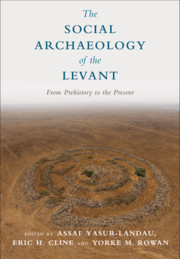Book contents
- The Social Archaeology of the Levant
- The Social Archaeology of the Levant
- Copyright page
- Contents
- Figures
- Tables
- Contributors
- Foreword
- Acknowledgments
- Abbreviations
- Prologue
- Part One
- One The Lower and Middle Paleolithic of the Southern Levant
- Two An Anthropological Review of the Upper Paleolithic in the Southern Levant
- Three The Forager–Farmer Transition in the Southern Levant (ca. 20,000–8,500 cal. BP)
- Four Getting It Together
- Five Fire and Society in the Eastern Mediterranean
- Six It’s a Small World
- Seven The Spiritual and Social Landscape during the Chalcolithic Period
- Eight Using Archaeobotanical Remains to Model Social, Political, and Economic Changes during the Chalcolithic Period in the Southern Levant
- Part Two
- Part Three
- Part Four
- Part Five
- Part Six
- Epilogue
- Index
- References
Four - Getting It Together
The Creation of Community in the Neolithic
from Part One
Published online by Cambridge University Press: 14 December 2018
- The Social Archaeology of the Levant
- The Social Archaeology of the Levant
- Copyright page
- Contents
- Figures
- Tables
- Contributors
- Foreword
- Acknowledgments
- Abbreviations
- Prologue
- Part One
- One The Lower and Middle Paleolithic of the Southern Levant
- Two An Anthropological Review of the Upper Paleolithic in the Southern Levant
- Three The Forager–Farmer Transition in the Southern Levant (ca. 20,000–8,500 cal. BP)
- Four Getting It Together
- Five Fire and Society in the Eastern Mediterranean
- Six It’s a Small World
- Seven The Spiritual and Social Landscape during the Chalcolithic Period
- Eight Using Archaeobotanical Remains to Model Social, Political, and Economic Changes during the Chalcolithic Period in the Southern Levant
- Part Two
- Part Three
- Part Four
- Part Five
- Part Six
- Epilogue
- Index
- References
- Type
- Chapter
- Information
- The Social Archaeology of the LevantFrom Prehistory to the Present, pp. 67 - 85Publisher: Cambridge University PressPrint publication year: 2018

